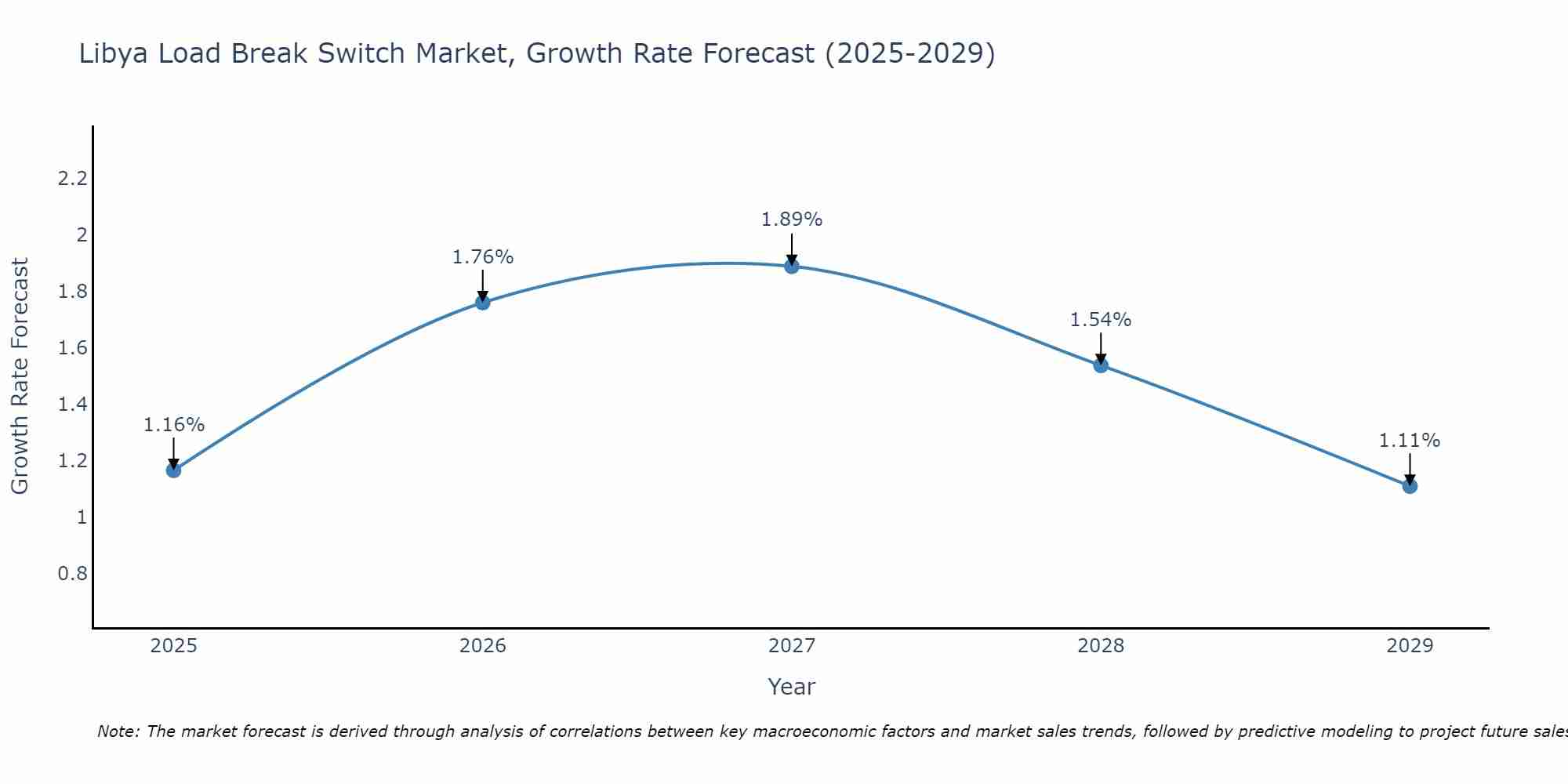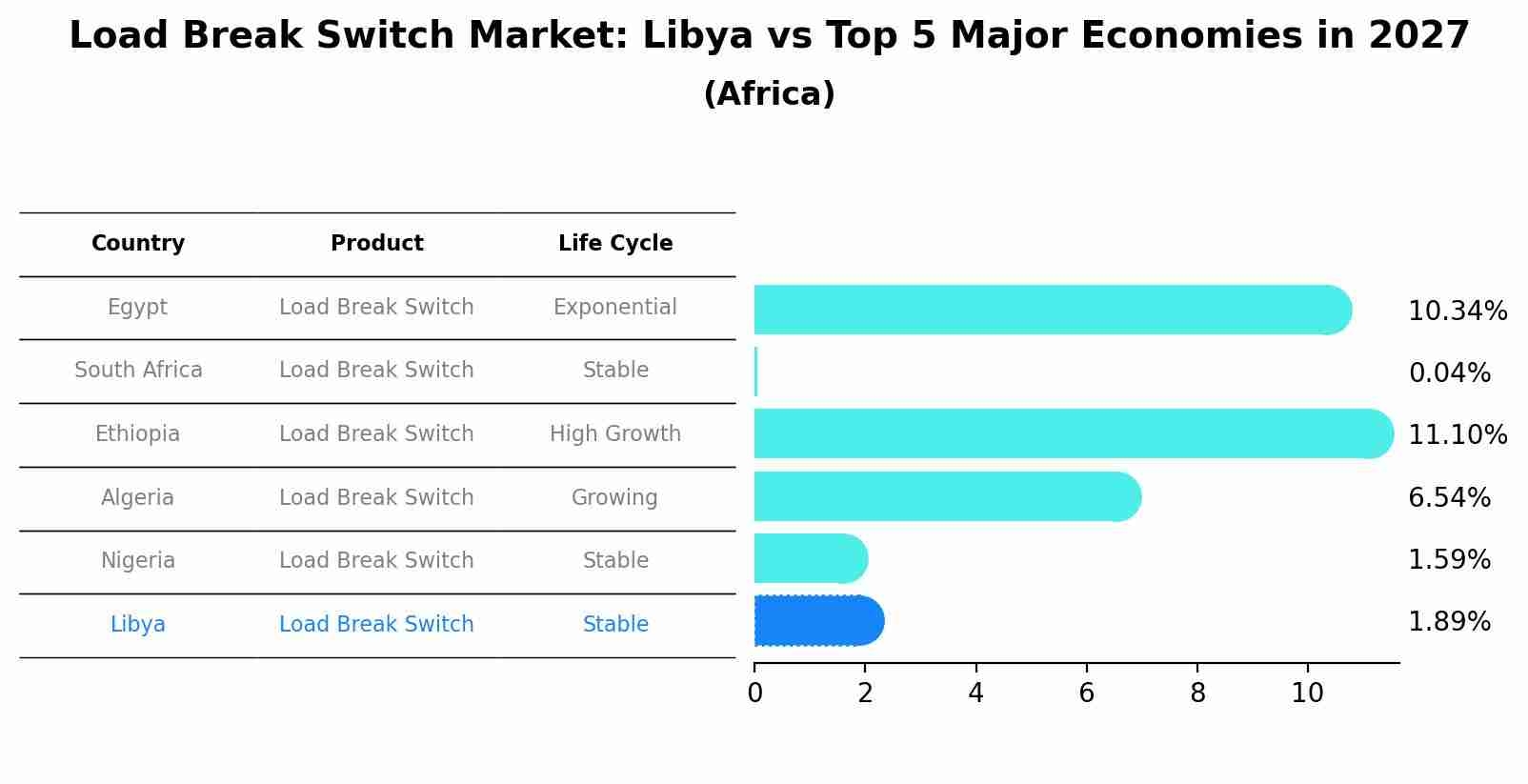Libya Load Break Switch Market (2025-2031) | Trends, Value, Segmentation, Revenue, Companies, Forecast, Analysis, Outlook, Growth, Industry, Share & Size
| Product Code: ETC5128271 | Publication Date: Nov 2023 | Updated Date: Sep 2025 | Product Type: Market Research Report | |
| Publisher: 6Wresearch | Author: Shubham Padhi | No. of Pages: 60 | No. of Figures: 30 | No. of Tables: 5 |
Libya Load Break Switch Market Size Growth Rate
The Libya Load Break Switch Market is projected to witness mixed growth rate patterns during 2025 to 2029. Starting at 1.16% in 2025, the market peaks at 1.89% in 2027, and settles at 1.11% by 2029.

Load Break Switch Market: Libya vs Top 5 Major Economies in 2027 (Africa)
The Load Break Switch market in Libya is projected to grow at a stable growth rate of 1.89% by 2027, highlighting the country's increasing focus on advanced technologies within the Africa region, where Egypt holds the dominant position, followed closely by South Africa, Ethiopia, Algeria and Nigeria, shaping overall regional demand.

Key Highlights of the Report:
- Libya Load Break Switch Market Outlook
- Market Size of Libya Load Break Switch Market, 2024
- Forecast of Libya Load Break Switch Market, 2031
- Historical Data and Forecast of Libya Load Break Switch Revenues & Volume for the Period 2021-2031
- Libya Load Break Switch Market Trend Evolution
- Libya Load Break Switch Market Drivers and Challenges
- Libya Load Break Switch Price Trends
- Libya Load Break Switch Porter`s Five Forces
- Libya Load Break Switch Industry Life Cycle
- Historical Data and Forecast of Libya Load Break Switch Market Revenues & Volume By Type for the Period 2021-2031
- Historical Data and Forecast of Libya Load Break Switch Market Revenues & Volume By Gas-Insulated for the Period 2021-2031
- Historical Data and Forecast of Libya Load Break Switch Market Revenues & Volume By Air-Insulated for the Period 2021-2031
- Historical Data and Forecast of Libya Load Break Switch Market Revenues & Volume By Others for the Period 2021-2031
- Historical Data and Forecast of Libya Load Break Switch Market Revenues & Volume By Deployment for the Period 2021-2031
- Historical Data and Forecast of Libya Load Break Switch Market Revenues & Volume By Outdoor for the Period 2021-2031
- Historical Data and Forecast of Libya Load Break Switch Market Revenues & Volume By Indoor for the Period 2021-2031
- Historical Data and Forecast of Libya Load Break Switch Market Revenues & Volume By End-User for the Period 2021-2031
- Historical Data and Forecast of Libya Load Break Switch Market Revenues & Volume By Utilities for the Period 2021-2031
- Historical Data and Forecast of Libya Load Break Switch Market Revenues & Volume By Commercial for the Period 2021-2031
- Historical Data and Forecast of Libya Load Break Switch Market Revenues & Volume By Industrial for the Period 2021-2031
- Libya Load Break Switch Import Export Trade Statistics
- Market Opportunity Assessment By Type
- Market Opportunity Assessment By Deployment
- Market Opportunity Assessment By End-User
- Libya Load Break Switch Top Companies Market Share
- Libya Load Break Switch Competitive Benchmarking By Technical and Operational Parameters
- Libya Load Break Switch Company Profiles
- Libya Load Break Switch Key Strategic Recommendations
Frequently Asked Questions About the Market Study (FAQs):
1 Executive Summary |
2 Introduction |
2.1 Key Highlights of the Report |
2.2 Report Description |
2.3 Market Scope & Segmentation |
2.4 Research Methodology |
2.5 Assumptions |
3 Libya Load Break Switch Market Overview |
3.1 Libya Country Macro Economic Indicators |
3.2 Libya Load Break Switch Market Revenues & Volume, 2021 & 2031F |
3.3 Libya Load Break Switch Market - Industry Life Cycle |
3.4 Libya Load Break Switch Market - Porter's Five Forces |
3.5 Libya Load Break Switch Market Revenues & Volume Share, By Type, 2021 & 2031F |
3.6 Libya Load Break Switch Market Revenues & Volume Share, By Deployment, 2021 & 2031F |
3.7 Libya Load Break Switch Market Revenues & Volume Share, By End-User, 2021 & 2031F |
4 Libya Load Break Switch Market Dynamics |
4.1 Impact Analysis |
4.2 Market Drivers |
4.2.1 Increasing demand for reliable power distribution systems in Libya |
4.2.2 Growing investments in infrastructure development projects |
4.2.3 Government initiatives to improve electricity access and reliability |
4.3 Market Restraints |
4.3.1 Political instability and security concerns in Libya |
4.3.2 Economic challenges impacting infrastructure investments |
4.3.3 Lack of skilled workforce and technical expertise |
5 Libya Load Break Switch Market Trends |
6 Libya Load Break Switch Market Segmentations |
6.1 Libya Load Break Switch Market, By Type |
6.1.1 Overview and Analysis |
6.1.2 Libya Load Break Switch Market Revenues & Volume, By Gas-Insulated, 2021-2031F |
6.1.3 Libya Load Break Switch Market Revenues & Volume, By Air-Insulated, 2021-2031F |
6.1.4 Libya Load Break Switch Market Revenues & Volume, By Others, 2021-2031F |
6.2 Libya Load Break Switch Market, By Deployment |
6.2.1 Overview and Analysis |
6.2.2 Libya Load Break Switch Market Revenues & Volume, By Outdoor, 2021-2031F |
6.2.3 Libya Load Break Switch Market Revenues & Volume, By Indoor, 2021-2031F |
6.3 Libya Load Break Switch Market, By End-User |
6.3.1 Overview and Analysis |
6.3.2 Libya Load Break Switch Market Revenues & Volume, By Utilities, 2021-2031F |
6.3.3 Libya Load Break Switch Market Revenues & Volume, By Commercial, 2021-2031F |
6.3.4 Libya Load Break Switch Market Revenues & Volume, By Industrial, 2021-2031F |
7 Libya Load Break Switch Market Import-Export Trade Statistics |
7.1 Libya Load Break Switch Market Export to Major Countries |
7.2 Libya Load Break Switch Market Imports from Major Countries |
8 Libya Load Break Switch Market Key Performance Indicators |
8.1 Percentage increase in government spending on energy infrastructure projects |
8.2 Rate of adoption of smart grid technologies in Libya |
8.3 Number of new partnerships and collaborations between local and international players in the market |
9 Libya Load Break Switch Market - Opportunity Assessment |
9.1 Libya Load Break Switch Market Opportunity Assessment, By Type, 2021 & 2031F |
9.2 Libya Load Break Switch Market Opportunity Assessment, By Deployment, 2021 & 2031F |
9.3 Libya Load Break Switch Market Opportunity Assessment, By End-User, 2021 & 2031F |
10 Libya Load Break Switch Market - Competitive Landscape |
10.1 Libya Load Break Switch Market Revenue Share, By Companies, 2024 |
10.2 Libya Load Break Switch Market Competitive Benchmarking, By Operating and Technical Parameters |
11 Company Profiles |
12 Recommendations | 13 Disclaimer |
- Single User License$ 1,995
- Department License$ 2,400
- Site License$ 3,120
- Global License$ 3,795
Search
Thought Leadership and Analyst Meet
Our Clients
Related Reports
- Vietnam System Integrator Market (2025-2031) | Size, Companies, Analysis, Industry, Value, Forecast, Growth, Trends, Revenue & Share
- ASEAN and Thailand Brain Health Supplements Market (2025-2031) | Strategy, Consumer Insights, Analysis, Investment Trends, Opportunities, Growth, Size, Share, Industry, Revenue, Segments, Value, Segmentation, Supply, Forecast, Restraints, Outlook, Competition, Drivers, Trends, Demand, Pricing Analysis, Competitive, Strategic Insights, Companies, Challenges
- ASEAN Bearings Market (2025-2031) | Strategy, Consumer Insights, Analysis, Investment Trends, Opportunities, Growth, Size, Share, Industry, Revenue, Segments, Value, Segmentation, Supply, Forecast, Restraints, Outlook, Competition, Drivers, Trends, Demand, Pricing Analysis, Competitive, Strategic Insights, Companies, Challenges
- Europe Flooring Market (2025-2031) | Outlook, Share, Industry, Trends, Forecast, Companies, Revenue, Size, Analysis, Growth & Value
- Saudi Arabia Manlift Market (2025-2031) | Outlook, Size, Growth, Trends, Companies, Industry, Revenue, Value, Share, Forecast & Analysis
- Uganda Excavator, Crane, and Wheel Loaders Market (2025-2031) | Strategy, Consumer Insights, Analysis, Investment Trends, Opportunities, Growth, Size, Share, Industry, Revenue, Segments, Value, Segmentation, Supply, Forecast, Restraints, Outlook, Competition, Drivers, Trends, Demand, Pricing Analysis, Competitive, Strategic Insights, Companies, Challenges
- Rwanda Excavator, Crane, and Wheel Loaders Market (2025-2031) | Strategy, Consumer Insights, Analysis, Investment Trends, Opportunities, Growth, Size, Share, Industry, Revenue, Segments, Value, Segmentation, Supply, Forecast, Restraints, Outlook, Competition, Drivers, Trends, Demand, Pricing Analysis, Competitive, Strategic Insights, Companies, Challenges
- Kenya Excavator, Crane, and Wheel Loaders Market (2025-2031) | Strategy, Consumer Insights, Analysis, Investment Trends, Opportunities, Growth, Size, Share, Industry, Revenue, Segments, Value, Segmentation, Supply, Forecast, Restraints, Outlook, Competition, Drivers, Trends, Demand, Pricing Analysis, Competitive, Strategic Insights, Companies, Challenges
- Angola Excavator, Crane, and Wheel Loaders Market (2025-2031) | Strategy, Consumer Insights, Analysis, Investment Trends, Opportunities, Growth, Size, Share, Industry, Revenue, Segments, Value, Segmentation, Supply, Forecast, Restraints, Outlook, Competition, Drivers, Trends, Demand, Pricing Analysis, Competitive, Strategic Insights, Companies, Challenges
- Israel Intelligent Transport System Market (2025-2031) | Strategy, Consumer Insights, Analysis, Investment Trends, Opportunities, Growth, Size, Share, Industry, Revenue, Segments, Value, Segmentation, Supply, Forecast, Restraints, Outlook, Competition, Drivers, Trends, Demand, Pricing Analysis, Competitive, Strategic Insights, Companies, Challenges
Industry Events and Analyst Meet
Whitepaper
- Middle East & Africa Commercial Security Market Click here to view more.
- Middle East & Africa Fire Safety Systems & Equipment Market Click here to view more.
- GCC Drone Market Click here to view more.
- Middle East Lighting Fixture Market Click here to view more.
- GCC Physical & Perimeter Security Market Click here to view more.
6WResearch In News
- Doha a strategic location for EV manufacturing hub: IPA Qatar
- Demand for luxury TVs surging in the GCC, says Samsung
- Empowering Growth: The Thriving Journey of Bangladesh’s Cable Industry
- Demand for luxury TVs surging in the GCC, says Samsung
- Video call with a traditional healer? Once unthinkable, it’s now common in South Africa
- Intelligent Buildings To Smooth GCC’s Path To Net Zero


















